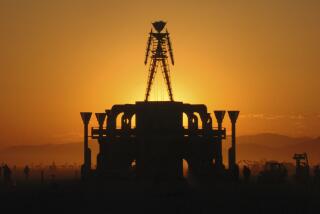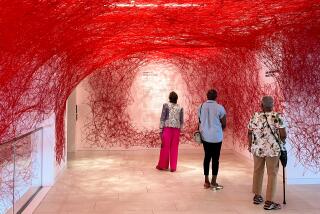Smithsonian Says It Erred, Scraps Exhibit on A-Bomb : Museum: Critics charged that it portrayed the U.S. as aggressors. The controversy hurt institutionâs funding.
WASHINGTON â In a victory for World War II veterans, the Smithsonian Institution backed down Monday from plans to commemorate the first use of the atomic bomb with an exhibit that critics charged would portray the United States as heartless aggressors at the close of the war against Japan.
âWe made a basic error,â Smithsonian Secretary I. Michael Heyman said in describing how the Smithsonian became embroiled in a yearlong controversy that not only questioned the museumâs intentions but caused a slump in museum funding.
âI have a number of regrets about this sad situation,â said Heyman, an ex-Marine who has headed the prestigious institution for just four months.
The museum, which serves as trustee of the nationâs heritage, had planned to use the Enola Gay--the B-29 Superfortress that carried the first atomic bomb--as the central exhibit in a display showing the destruction that incinerated two Japanese cities in the last days of World War II.
Heyman announced that the institution will scrap its ambitious display titled âThe Last Act: The Atomic Bomb and the End of World War II,â which was to feature photographs and oral histories of the destruction.
In its place, the National Air and Space Museum will use only the fuselage of the bomber and a video of recollections from its flight crew. There will be no written or video commentary on how the atomic bombs released over Hiroshima and Nagasaki catapulted the world into the Nuclear Age.
The controversy enveloped the Smithsonian a year ago, when a 500-page script for the exhibit surfaced and critics charged that it emphasized the horror and suffering of Japanese civilians at the hands of American aggression. The bombs killed 210,000 Japanese.
They also argued that the tone of the script suggested that the United States should not have dropped the bombs in August, 1945, a situation that many veterans and historians said was unfair. The bombs, they said, saved hundreds of thousands of Allied lives by making an invasion of Japan unnecessary.
The initial criticism was followed by a series of attempts to rewrite the script that in turn drew complaints from other historians and from anti-nuclear war activists that history was being cleaned up to satisfy U.S. veterans.
At the core of the debate was the number of casualties that would have been expected in an invasion of Japan. When National Air and Space Museum Director Martin Harwit lowered that number from 229,000 in the script to 63,000, based on a recommendation from Barton Bernstein, a Stanford University academician, the American Legion and other veterans groups were so incensed that last week they demanded that the entire exhibit be scuttled.
For veterans, led by the national American Legion officials here, the victory was bittersweet.
American Legion National Commander William M. Detweiler said the controversy âinflicted grave damageâ on the prestige of the Smithsonian, especially as it approaches its 150th anniversary next year.
The fight over the exhibit, Detweiler said, also came at âno small costâ to World War II veterans humiliated by the museum curatorsâ attempt to depict the Japanese as victims and Americans as coldhearted avengers of the 1941 attack on Pearl Harbor.
âIn that sense,â Detweiler said, âthe battle over this exhibit is a metaphor for the very war it purported to record and its outcome a metaphor for the warâs climactic last act.
âThe winners, just as they were 50 years ago, are the American people.â
Others were disappointed, however, including representatives of Physicians for Social Responsibility, which is dedicated to studying the Nuclear Age and had urged the museum to include depiction of the death and destruction in Japan.
Robert K. Musil, director of policy and programs for the organization, said that âmerely showing a plane does nothingâ to advance the historical significance of Hiroshima.
âWhen you go to the museum of record of the United States, you expect the full story,â Musil said. âBut having history interpreted by political passion and by congressional investigation is the worst way to do history.â
On Capitol Hill, many lawmakers have called for congressional hearings into how the federally funded Smithsonian could have gotten itself into such a bind. House Speaker Newt Gingrich (R-Ga.) said Monday that the Smithsonian made a âa very wise decisionâ in narrowing the exhibit. âThe academicians had overreached,â he said.
At the White House, Press Secretary Mike McCurry said that President Clinton supports the decision. Although he believes that academic freedom was an issue of concern, the President ânonetheless felt that some of the concerns expressed by veteransâ groups and others had merit,â the press secretary said.
Heyman said a more detailed Enola Gay exhibit, specifically including debate over the use of nuclear weapons, will be displayed at a future date at Dulles International Airport outside Washington.
He also promised an aggressive internal investigation to learn how and why the exhibit went forward without gauging public reaction. âThe institution has much to learn from this experience,â he said.
At the same time, Heyman acknowledged that there had been delays in some badly needed private financial contributions to the Smithsonian. âI do know,â he said, âthat there are some gifts we will receive that have been holding fire until this controversy can be resolved.â
Detweiler said his argument was not with the need for historians to revisit the horrors of atomic destruction. Nor, he said, was he trying to censor history.
Rather, as the representative of 3.1 million American wartime veterans, Detweiler said, his concern was that the Smithsonian was trying to âwrapâ the political debate over nuclear weapons into what should be a 50-year tribute to the end of the worst war in this century.
World War II commemorations should stand alone as memorials to the soldiers who died fighting aggression, Detweiler said, as well as to the hundreds of thousands of lives--both American and Japanese--that were saved when President Harry S. Truman averted an invasion of Japan and ordered the Enola Gay aloft.
âThat is all Americaâs veterans ever asked,â he said.
More to Read
Sign up for Essential California
The most important California stories and recommendations in your inbox every morning.
You may occasionally receive promotional content from the Los Angeles Times.











